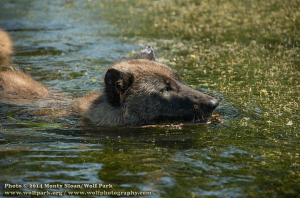 Wolves have always triggered strong emotional reactions in people. Some fear them, others love them, but rare are those indifferent to this intelligent, powerful and mysterious animal. Wolves have fascinated mankind for millennia, which is one reason why so many ideas we have about pet dogs are directly inspired by how we think of wolves. But what do we really know about wolves? Indiana is certainly not well known for any grandiose monument, but if there is one special place to visit as an animal lover, it’s the Wolf Park in Lafayette IN. Nestled on 75 acres of farmland, Wolf Park houses wolves in semi-natural conditions and offers a unique opportunity to learn about wolf behavior. Since Professor Klinghammer brought the first two wolves some 40 years ago, the park has provided invaluable information about those fascinating animals. Sadly Dr. Klinghammer passed a few years ago, but the staff at Wolf Park continue his legacy of education and research on wolf behavior. Do wolves truly have a social structure and how does that work? Can wolves be kept as pets? Can they be trained like dogs? What can we learn about wolves that can help us better understand our dogs? Here are a few guidelines applied at the Wolf Park with their animals (From ‘The Management and Socialization of Captive Wolves at Wolf Park, by Klighammer E. & Goodman P, 1985).
Wolves have always triggered strong emotional reactions in people. Some fear them, others love them, but rare are those indifferent to this intelligent, powerful and mysterious animal. Wolves have fascinated mankind for millennia, which is one reason why so many ideas we have about pet dogs are directly inspired by how we think of wolves. But what do we really know about wolves? Indiana is certainly not well known for any grandiose monument, but if there is one special place to visit as an animal lover, it’s the Wolf Park in Lafayette IN. Nestled on 75 acres of farmland, Wolf Park houses wolves in semi-natural conditions and offers a unique opportunity to learn about wolf behavior. Since Professor Klinghammer brought the first two wolves some 40 years ago, the park has provided invaluable information about those fascinating animals. Sadly Dr. Klinghammer passed a few years ago, but the staff at Wolf Park continue his legacy of education and research on wolf behavior. Do wolves truly have a social structure and how does that work? Can wolves be kept as pets? Can they be trained like dogs? What can we learn about wolves that can help us better understand our dogs? Here are a few guidelines applied at the Wolf Park with their animals (From ‘The Management and Socialization of Captive Wolves at Wolf Park, by Klighammer E. & Goodman P, 1985).
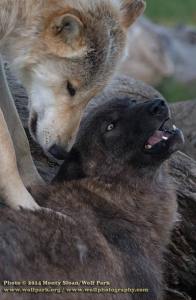 As a means to minimize stress to the wolves and facilitate care, handling and studying, all the wolves at Wolf Park are carefully hand raised as soon as they reach 8-10 days old. Once wolf cubs turn 21 days old, they’re so fearful of people that socialization to humans becomes very time consuming if at all possible. When raised by people with their littermates, but away from the other wolves, they’re more likely to be comfortable around humans for life. At 4 months old, they’ll return to their pack. Even with such measures however and constant presence of humans throughout their life, wolves remain skeptical creatures and they will always be a little reserved with new people.
As a means to minimize stress to the wolves and facilitate care, handling and studying, all the wolves at Wolf Park are carefully hand raised as soon as they reach 8-10 days old. Once wolf cubs turn 21 days old, they’re so fearful of people that socialization to humans becomes very time consuming if at all possible. When raised by people with their littermates, but away from the other wolves, they’re more likely to be comfortable around humans for life. At 4 months old, they’ll return to their pack. Even with such measures however and constant presence of humans throughout their life, wolves remain skeptical creatures and they will always be a little reserved with new people.
The wolves also undergo a fair amount of training. We’re not talking about obedience training here, but like any other species in captivity, for husbandry purposes, it’s important to take the time to teach them a number of skills. Wolves, hand raised or not, are sensitive to anything novel in the environment. They will be curious and scared at the same time. Any new object, noise or cage needs to be introduced gradually through a process of habituation. Wolves will also avoid at all costs anything that they experienced as unpleasant. So using any aversive on a wolf will have lasting consequences that will be very time consuming to overcome. If a wolf is spooked at all during a physical examination, he/she will be very difficult to handle in the future. When working with an animal that will have such reactions to aversives, it becomes critical for the staff to learn how to shape and reward any desired behavior and stay away from any punitive methods. Staff also learns to pay very close attention to how they may inadvertently reinforce or punish the wolves with their own attitudes or behavior.
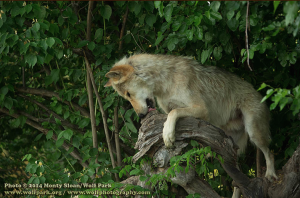 Just like dogs, wolves also need to learn how to walk on leash so they can safely be walked from one place to another. Because a wolf can section a leash in just one bite the handlers use heavy chains, 8-10 feet long. Choke chains or prong collars should never be used on wolves, according to Klinghammer and Goodman, ‘wolves are insensitive to any pain such collars may cause, but if the collar strangles them they will panic and that may end leash training for the rest of the wolf’s life.’ Another problem with such equipment is that if a wolf is forced at all, it may bite or even attack the obstinate handler. Teaching a wolf to walk on leash is never a matter of exerting will over the animal. It’s about gradually getting the animal used to being restrained without making it a frightening experience.
Just like dogs, wolves also need to learn how to walk on leash so they can safely be walked from one place to another. Because a wolf can section a leash in just one bite the handlers use heavy chains, 8-10 feet long. Choke chains or prong collars should never be used on wolves, according to Klinghammer and Goodman, ‘wolves are insensitive to any pain such collars may cause, but if the collar strangles them they will panic and that may end leash training for the rest of the wolf’s life.’ Another problem with such equipment is that if a wolf is forced at all, it may bite or even attack the obstinate handler. Teaching a wolf to walk on leash is never a matter of exerting will over the animal. It’s about gradually getting the animal used to being restrained without making it a frightening experience.
 Ideas of wolf behavior have mislead dog trainers and guardians into thinking that the best way to keep our pooches under control, well-behaved and happy is to let the dog know when he/she is crossing the line. Yet, according to those who work with wolves day in and day out adult wolves should never be slapped, hit or generally disciplined for any reason. Even though many might be tempted in trying to punish the animal for making the wrong decision, any attempt to control or correct a wolf should be completely avoided. Why? Because such methods are likely to bring out defensive and aggressive reactions in the wolf. Handlers with a ‘macho’ attitude, wanting to exert control over the ‘beast’ typically end up with stressed out and potentially dangerous animals.
Ideas of wolf behavior have mislead dog trainers and guardians into thinking that the best way to keep our pooches under control, well-behaved and happy is to let the dog know when he/she is crossing the line. Yet, according to those who work with wolves day in and day out adult wolves should never be slapped, hit or generally disciplined for any reason. Even though many might be tempted in trying to punish the animal for making the wrong decision, any attempt to control or correct a wolf should be completely avoided. Why? Because such methods are likely to bring out defensive and aggressive reactions in the wolf. Handlers with a ‘macho’ attitude, wanting to exert control over the ‘beast’ typically end up with stressed out and potentially dangerous animals.
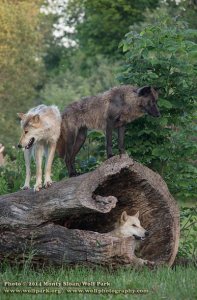 No matter how socialized they may be to people, wolves are not domesticated animals. They have their own interpretation of the world and when they feel threatened they are likely to defend themselves. They are also pack animals and as such, they may use threats and other aggressive displays with one another. Amongst captive wolves, there can be more reasons for competition and social struggles than with wild wolves. If we remember, many assumptions that we had about wolf pack behavior had been based on observations of captive wolves. It was later found that wild packs have much more of a family structure with a mated pair and their offspring.
No matter how socialized they may be to people, wolves are not domesticated animals. They have their own interpretation of the world and when they feel threatened they are likely to defend themselves. They are also pack animals and as such, they may use threats and other aggressive displays with one another. Amongst captive wolves, there can be more reasons for competition and social struggles than with wild wolves. If we remember, many assumptions that we had about wolf pack behavior had been based on observations of captive wolves. It was later found that wild packs have much more of a family structure with a mated pair and their offspring.
Amongst dog trainers, there has been such a misunderstanding around pack theory that some misuse it, others simply reject it. Hierarchy in animals does exist however and in other species it’s not a controversial subject like it is in dogs. It’s the interpretation we’ve made of it that has led to so many erroneous ideas and abuses in dogs. As Patricia McConnell Ph.D. pointed out in the last SPARCS conference, it’s not that dogs don’t create a social hierarchy, but their predisposition to do so is highly variable. “It matters to some dogs, not to others” (for more details on the subject see blog “When science and dog training come together – SPARCS 2014“). Dominance is a prediction of who’s going to get the resource in a competitive situation. It has nothing to do with whether or not a dog will come when called or bark at other dogs when on leash. So it’s not that the concept of dominance doesn’t exist at all, just not in the way some trainers have been interpreting and applying it.
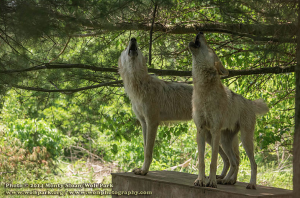 In wolves, as in dogs, one big lesson to learn from Wolf Park is that even if there is a social structure among the individuals of a given group, it’s still not relevant for people to try to interact with the wolves in similar ways, or in ways that we think we understand from a hierarchy perspective. A wolf will never hit another wolf or even forcefully take food away from another, even if the other wolf is a subordinate. They don’t punish another wolf for exploring the environment like we might be tempted to do when we find our best pair of shoes destroyed. The concept of dominance simply isn’t relevant in interacting or training either wolves or dogs. Building the desired behaviors through management and positive reinforcement is a much more efficient and safe way to interact with wolves, avoiding unnecessary stress and making life easier and more pleasant for both the animals and their caregivers.
In wolves, as in dogs, one big lesson to learn from Wolf Park is that even if there is a social structure among the individuals of a given group, it’s still not relevant for people to try to interact with the wolves in similar ways, or in ways that we think we understand from a hierarchy perspective. A wolf will never hit another wolf or even forcefully take food away from another, even if the other wolf is a subordinate. They don’t punish another wolf for exploring the environment like we might be tempted to do when we find our best pair of shoes destroyed. The concept of dominance simply isn’t relevant in interacting or training either wolves or dogs. Building the desired behaviors through management and positive reinforcement is a much more efficient and safe way to interact with wolves, avoiding unnecessary stress and making life easier and more pleasant for both the animals and their caregivers.
When wolves are hand raised, they will treat people almost as if they were other wolves. They will test the humans, just like they continuously test other pack members. In other words, people need to respond to any challenge appropriately. Sometimes such provocation may lead to an all-out attack! While we may be tempted in believing that ‘showing the wolf who’s boss’ may be a good idea, the outcome of such treatment is generally to the worst. Let’s face it; we’re really not equipped to threaten a wolf, let alone, to have a full-blown fight with one. We can’t raise our hackles and our canine teeth are not anything worth showing. Another problem is that most of the time, the signs preceding an attack are so subtle to the untrained eye that it’s likely to ‘come out of the blue’. The better approach: understanding wolf behavior and pack dynamics to avoid being in such situations in the first place! Behaving with a friendly yet confident attitude will be treated with respect. To those who know them well, wolves are quite predictable, as long as you know how to read them and what will trigger them based on their individual history.
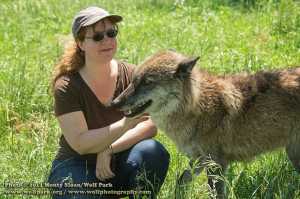 At Wolf Park, the wolves enjoy meeting new people. It’s a chance for entertainment in their otherwise boring captive life. Before entering the wolf enclosures however, the staff carefully instructs any guest about wolf behavior. What to do when a wolf comes near you, how do you pet a wolf, how do you avoid threatening a wolf, what do you do if a wolf jumps on you, nudges you, etc? With decades of experience, the staff of Wolf Park has developed a solid understanding of wolf behavior and offers a unique experience to their VIP visitors. Exciting and humbling, being in the presence of such amazing creatures, is nothing less than a breathtaking experience. I had the privilege of spending some time with the wolves during a recent seminar at the Wolf Park. I’m sharing with you some of the incredible pictures taken by their photographer, Monty Sloan during my close encounters with them.
At Wolf Park, the wolves enjoy meeting new people. It’s a chance for entertainment in their otherwise boring captive life. Before entering the wolf enclosures however, the staff carefully instructs any guest about wolf behavior. What to do when a wolf comes near you, how do you pet a wolf, how do you avoid threatening a wolf, what do you do if a wolf jumps on you, nudges you, etc? With decades of experience, the staff of Wolf Park has developed a solid understanding of wolf behavior and offers a unique experience to their VIP visitors. Exciting and humbling, being in the presence of such amazing creatures, is nothing less than a breathtaking experience. I had the privilege of spending some time with the wolves during a recent seminar at the Wolf Park. I’m sharing with you some of the incredible pictures taken by their photographer, Monty Sloan during my close encounters with them.
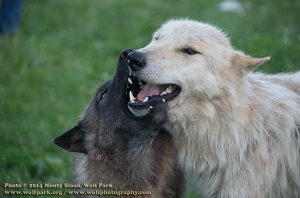 We grew up with stories of the ‘Big Bad Wolf’ or ‘White Fang’. Wolves have been portrayed as blood thirsty beasts or, on the contrary, they have been overly romanticized. As a result, they are hunted to the point of near extermination in the wild but also raised as pets in the homes of their admirers. The reality is as always, much more complicated and wolves are neither threatening to our safety nor do they make safe pets. When working with dogs, learning about wolf behavior would allow us to better understand our dogs. After all, if we believe that our treatment of dogs should be influenced on the behavior of their wild cousins, shouldn’t we first make sure that our basic information is as thorough and accurate as possible?
We grew up with stories of the ‘Big Bad Wolf’ or ‘White Fang’. Wolves have been portrayed as blood thirsty beasts or, on the contrary, they have been overly romanticized. As a result, they are hunted to the point of near extermination in the wild but also raised as pets in the homes of their admirers. The reality is as always, much more complicated and wolves are neither threatening to our safety nor do they make safe pets. When working with dogs, learning about wolf behavior would allow us to better understand our dogs. After all, if we believe that our treatment of dogs should be influenced on the behavior of their wild cousins, shouldn’t we first make sure that our basic information is as thorough and accurate as possible?
Jennifer Cattet Ph.D.


Excellent insight, we humans can be so dim sometimes:)
I disagree, some inaccurate interpretations and several contradictions. not a good article overall. besides poor editing in missing weather for whether. best part is that dogs are not wolves and studying wolves doesn’t mean much with dogs with what McConnely indicated yet that is contradicted at the end.
another contradiction was the idea dominance between wolves and humans is irrelevant and the next paragraph stating wolves test humans constantly and treat them like other wolves.
last is that studying wolves in captivity or even restricted populations like Isle Royale doesn’t reflect their behavior when not restrained by geography or fencing. In the wild, both sexes leave the pack at maturity. The breeding pair usually boots out the same sex offspring when the female goes into estrus. They may roam 1000 miles or more to find a mate and start their own pack. Captivity and islands skew this and don’t reflect situations they would choose.